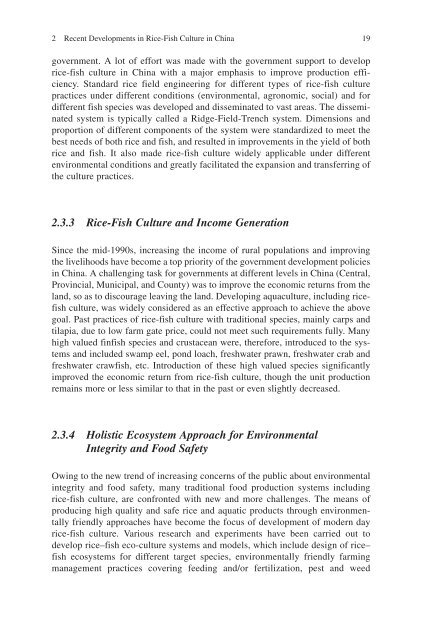Success Stories In Asian Aquaculture - Library - Network of ...
Success Stories In Asian Aquaculture - Library - Network of ...
Success Stories In Asian Aquaculture - Library - Network of ...
- No tags were found...
You also want an ePaper? Increase the reach of your titles
YUMPU automatically turns print PDFs into web optimized ePapers that Google loves.
2 Recent Developments in Rice-Fish Culture in China19government. A lot <strong>of</strong> effort was made with the government support to developrice-fish culture in China with a major emphasis to improve production efficiency.Standard rice field engineering for different types <strong>of</strong> rice-fish culturepractices under different conditions (environmental, agronomic, social) and fordifferent fish species was developed and disseminated to vast areas. The disseminatedsystem is typically called a Ridge-Field-Trench system. Dimensions andproportion <strong>of</strong> different components <strong>of</strong> the system were standardized to meet thebest needs <strong>of</strong> both rice and fish, and resulted in improvements in the yield <strong>of</strong> bothrice and fish. It also made rice-fish culture widely applicable under differentenvironmental conditions and greatly facilitated the expansion and transferring <strong>of</strong>the culture practices.2.3.3 Rice-Fish Culture and <strong>In</strong>come GenerationSince the mid-1990s, increasing the income <strong>of</strong> rural populations and improvingthe livelihoods have become a top priority <strong>of</strong> the government development policiesin China. A challenging task for governments at different levels in China (Central,Provincial, Municipal, and County) was to improve the economic returns from theland, so as to discourage leaving the land. Developing aquaculture, including ricefishculture, was widely considered as an effective approach to achieve the abovegoal. Past practices <strong>of</strong> rice-fish culture with traditional species, mainly carps andtilapia, due to low farm gate price, could not meet such requirements fully. Manyhigh valued finfish species and crustacean were, therefore, introduced to the systemsand included swamp eel, pond loach, freshwater prawn, freshwater crab andfreshwater crawfish, etc. <strong>In</strong>troduction <strong>of</strong> these high valued species significantlyimproved the economic return from rice-fish culture, though the unit productionremains more or less similar to that in the past or even slightly decreased.2.3.4 Holistic Ecosystem Approach for Environmental<strong>In</strong>tegrity and Food SafetyOwing to the new trend <strong>of</strong> increasing concerns <strong>of</strong> the public about environmentalintegrity and food safety, many traditional food production systems includingrice-fish culture, are confronted with new and more challenges. The means <strong>of</strong>producing high quality and safe rice and aquatic products through environmentallyfriendly approaches have become the focus <strong>of</strong> development <strong>of</strong> modern dayrice-fish culture. Various research and experiments have been carried out todevelop rice–fish eco-culture systems and models, which include design <strong>of</strong> rice–fish ecosystems for different target species, environmentally friendly farmingmanagement practices covering feeding and/or fertilization, pest and weed
















